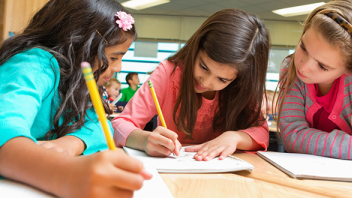Research and experience has told us that having social skills is essential for success in life. Inclusive teachers have always taught, provided and reinforced the use of good social skills in order to include and accommodate for the wide range of students in the classroom.
Essentially, inclusive classrooms are representations of the real world where people of all backgrounds and abilities co-exsist. In fact, there are school disctricts with curriculum specifically for social and emotional development.
Here are some ways in which you can create a more inclusive classroom and support social skill development in your students:
1. Model manners
If you expect your students to learn and display good social skills, then you need to lead by example. A teacher’s welcoming and positive attitude sets the tone of behaivor between the students. They learn how to intereact with one another and value individuals. For example, teachers who expect students to use “inside voices” shouldn’t be yelling at the class to get their attention. In other words, practice what you preach.
2. Assign classroom jobs
Assigning classroom jobs to students provides opportunties to demonstrate responsibility, teamwork and leadership. Jobs such as handing out papers, taking attendance, and being a line-leader can highlight a student’s strengths and in turn, build confidence. It also helps alleviate your workload! Teachers often rotate class jobs on a weekly or monthly basis, ensuring that every student has an opportunity to participate. Check out this list of classroom jobs for some ideas!
3. Role-play social situations
As any teacher knows, it’s important to not only teach the students a concept or lesson but then give them a chance to practice what they have learned. For example, if we teach students how to multiply, then we often provide a worksheet or activity for the students to show us their understanding of mulitiplication. The same holds true for teaching social skills. We need to provide students with opportunities to learn and practice their social skills. An effective method of practice is through role-playing. Teachers can provide structured scenarios in which the students can act out and offer immediate feedback. For more information on how to set-up and support effective role-playing in your classroom have a look at this resource from Learn Alberta .
4. Pen-pals
For years, I arranged for my students to become pen-pals with kids from another school. This activity was a favorite of mine on many different academic levels; most importantly it taught students how to demonstrate social skills through written communication. Particularly valuable for introverted personalities, writing letters gave students time to collect their thoughts. It levelled the playing field for students who had special needs or were non-verbal. I was also able to provide structured sentence frames in which the kids held polite conversation with their pen-pal. Setting up a pen-pal program in your classroom takes some preparation before the letter writing begins. You want to ensure that students have guidelines for content and personal safety. This article, Pen Pals in the 21st Century , from Edutopia will give you some ideas!
5. Large and small group activities
In addition to the academic benefits, large and small group activities can give students an opportunity to develop social skills such as teamwork, goal-setting and responsibility. Students are often assigned roles to uphold within the group such as Reporter, Scribe, or Time-Keeper. Sometimes these groups are self-determined and sometimes they are pre-arranged. Used selectively, group work can also help quieter students connect with others, appeals to extroverts, and reinforces respectful behavior. Examples of large group activities are group discussions, group projects and games. Smaller group activities can be used for more detailed assignments or activities. For suggestions on how to use grouping within your classroom, check out this article, Instructional Grouping in the Classroom .
6. Big buddies
We know that learning to interact with peers is a very important social skill. It is just as important to learn how to interact with others who may be younger or older. The Big Buddy system is a great way for students to learn how to communicate with and respect different age groups. Often an older class will pair up with a younger class for an art project, reading time or games. Again, this type of activity needs to be pre-planned and carefully designed with student’s strengths and interests in mind. Usually, classroom teachers meet ahead of time to create pairings of students and to prepare a structured activity. There is also time set aside for the teacher to set guidelines for interaction and ideas for conversation topics. Entire schools have also implemented buddy programs to enrich their student’s lives. Here is an article that offers tips on how to start a reading buddy program .
7. Class stories
There are dozens of stories for kids that teach social skills in direct or inadvertant ways. Find strategies to incoporate these stories in your class programs. You can set aside some time each day to read-aloud a story to the entire class or use a story to teach a lesson. Better yet, have your class write their own stories with characters who display certain character traits.
8. Class meeting
Class Meetings are a wonderful way to teach students how to be diplomatic, show leadership, solve problems and take responsibility. They are usually held weekly and are a time for students to discuss current classroom events and issues. Successful and productive meetings involve discussions centered around classroom concerns and not individual problems. In addition, it reinforces the value that each person brings to the class. Before a class meeting, teachers can provide the students with group guidelines for behavior, prompts, and sentence frames to facilitate meaningful conversation. Here is a great article, Class Meetings: A Democratic Approach to Classroom Management , from Education World that describes the purpose and attributes of a class meeting.
9. Explicit instruction
Finally, teachers can carve out a time in their curriculum to directly teach social skills to their students. Research-based programs such as Second Step provide teachers and schools with explicit lessons for social development. These programs can provide schools and classrooms with a common language, set of behavior expectations, and goals for the future. I have used programs such as Second Step in my classrooms with much success!
Nicole Eredics is an educator who specializes in the inclusion of students with disabilities in the general education classroom. She draws upon her years of experience as a full inclusion teacher to write, speak, and consult on the topic of inclusive education to various national and international organizations. She specializes in giving practical and easy-to-use solutions for inclusion. Nicole is creator of The Inclusive Class blog and author of a new guidebook for teachers and parents called, Inclusion in Action: Practical Strategies to Modify Your Curriculum . For more information about Nicole and all her work, visit her website .

